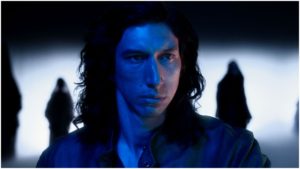
Opera Meets Film: How Leos Carax Spotlights Opera’s Inherent Misogyny in ‘Annette’
By David Salazar“Opera Meets Film” is a feature dedicated to exploring the way that opera has been employed in cinema. We will select a section or a film in its entirety, highlighting the impact that utilizing the operatic form or sections from an opera can alter our perception of a film that we are viewing. This week’s installment features Leo Carax’s “Annette.’
SPOILER ALERT: This article features major spoiler.
Leos Carax’s “Annette,”a musical / pop-opera / hybrid musical theatre, is not afraid to note its metatextual nature. The film literally opens with the director himself kicking off the recording before we get to see his major collaborators on the film walk around to the repetitive anthem “So may we start,” in which the actors are literally asking for the audience’s permission (but not really) to kick off the proceedings. For those counting, this is akin to an overture and the film, by the very nature of the “may we start” text is likely commenting on what Carax might be deeming as “extraneous” intro music.
Nonetheless, the number concludes and we watch as the two main characters, Ann (an opera singer) and Henry McHenry (a standup comedian, hence the name) go their separate ways to perform in their distinct shows. Henry the film’s focal point and throughout, Carax will focus on the male toxicity that Henry will slowly but surely embody.
The choice of an opera singer for Ann is no accident. And again, as with everything in this film, it’s heavily commented on from many angles. Henry never seems to tire about how Ann is constantly dying on stage before taking her bow. It’s a well-worn opera cliché (though many readers here might take issue with several exceptions, usually of the comedic variety). Of course, this idea of women constantly dying on the opera stage fits in with the major discourse on misogyny in many of the standard operatic staples. And Carax does not shy away from showing a montage of Ann dying in the work she is currently performing.
But Carax then suggests that the joke is growing old.
After the birth of the couple’s first (and only) child Annette, Henry heads to Las Vegas for another show. As he drives his motorcycle down a barren road, we hear and see another death montage, this time of superimposed images of Ann in a wide range of opera roles, dying at the end of each one. We see the endings of “Norma,” “Carmen,” “Otello,” “Madama Butterfly” and finally, “La Traviata.” And while the metaphor doesn’t hold equally for all of these operas, each one features a certain degree of male toxicity (and in the case of “Carmen” and “Otello,” murder of the woman at the hands of the man). Pollione cheats on Norma and abandons her and their children, leaving her in a compromised situation with her family and clan. Don José abuses and murders Carmen. Otello’s jealousy and insecurity leads him to unfairly murdering Desdemona. Pinkerton betrays Cio-Cio San, leaving her pregnant and alone. Finally, Germont imposed his social will on Violetta, leading to Alfredo harassing her publicly.
As portrayed in the film, this sequence of images follows a previous scene in which Ann dreams of women denouncing Henry for sexual harassment and abuse (among the women cast in this scene is soprano Julia Bullock). It’s a shocking moment because to this point, we’ve seen the couple rather happy together throughout. So this sudden series of images suggests a nefarious turn in the plot. The motorcycle / opera sequence furthers it and Henry’s subsequent performance, in which he claims to “kill his wife,” adds fuel to that fire.
We can start to feel the film teeter into full-on operatic melodrama, a sensation that is confirmed a few scenes later when Ann is murdered by her husband (in a stormy ocean that is clearly portrayed as a bunch of rear-projections, furthering the theatrical nature of it all). And just like that, Ann’s operatic prophecy is fulfilled, for real this time. It’s not a joke any more. The artifice of theater won’t bring her back for another bow (of course, real-life actor Marion Cotillard does come back).
But there’s still half a film to watch. And while overt references to opera are essentially absent from this point forward, “Annette’s” metatextual sense only develops further as it hones in on a father-daughter relationship. It can’t go unnoticed that a lot of the famed operas that focus on father-daughter dynamics leave out the mother character altogether. Here’s looking at such operas as “Rigoletto,” “Simon Boccanegra,” “La Forza del Destino,” “Aida,” “Iolanta,” “Der Fliegende Holländer,” “Turandot,” “Nabucco,” “La Traviata,” “Don Carlo,” “Giovanna d’Arco,” “Norma,” “Don Giovanni,” etc. You get the message.
And like many of those, this one heads to similarly tragic territory.
And for what? Why? Because Henry is a failure who needs women to give some degree of purpose to his life. Without them he is nothing. But he also needs to be in control of them as well. As the film draws to an end, Annette, portrayed as a puppet to that point, becomes a real girl (a very blatant Pinocchio reference) and takes charge of her own destiny, emphasizing how her father, now rotting in a prison, will be empty and without love. He never knew how to love and now he will suffer for it.
All of this is just scratching the surface on how Carax uses several forms of performance art within his film and critiques them implicitly and openly.
Categories
Opera Meets Film

